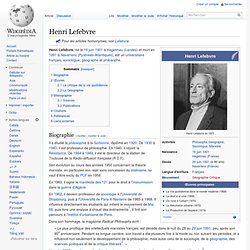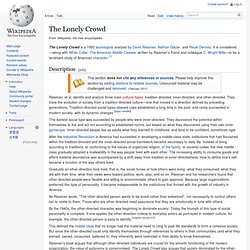

C. Wright Mills. Charles Wright Mills (August 28, 1916 – March 20, 1962) was an American sociologist, and a professor of sociology at Columbia University from 1946 until his death in 1962.

Mills was published widely in popular and intellectual journals, and is remembered for several books, among them The Power Elite, which introduced that term and describes the relationships and class alliances among the U.S. political, military, and economic elites; White Collar, on the American middle class; and The Sociological Imagination, where Mills proposes the proper relationship in sociological scholarship between biography and history. Mills was concerned with the responsibilities of intellectuals in post-World War II society, and advocated public and political engagement over uninterested observation. Mills biographer Daniel Geary writes that his writings had a "particularly significant impact on New Left social movements of the 1960s. Biography[edit] C. Influences[edit] C.
Kristin Ross. Kristin Ross (born 1953[1]) is a professor of comparative literature at New York University.

She is primarily known for her work on French literature and culture of the 19th and 20th centuries.[2] Life and work[edit] For Fast Cars, Clean Bodies, Ross was awarded a Critic's Choice Award and the Lawrence Wylie Award for French Cultural Studies. Professor Ross has also received a Guggenheim Fellowship and a fellowship from the Institute for Advanced Study in Princeton, New Jersey. Henri Lefebvre. Un article de Wikipédia, l'encyclopédie libre.

Pour les articles homonymes, voir Lefebvre. Henri Lefebvre Henri Lefebvre en 1971 Œuvres principales La Vie quotidienne dans le monde moderne (1968)Le droit à la ville (1968)Du rural à l'urbain (1970)La Révolution urbaine (1970)La Production de l'espace (1974) Biographie[modifier | modifier le code] Il a étudié la philosophie à la Sorbonne, diplômé en 1920. Son évolution au cours des années 1950 concernant la théorie marxiste, en particulier son rejet sans concession du stalinisme, lui vaut d’être exclu du PCF en 1958. En 1960, il signe le manifeste des 121 pour le droit à l'insoumission dans la guerre d'Algérie. En 1962, il devient professeur de sociologie à l'Université de Strasbourg, puis à l'Université de Paris X-Nanterre de 1965 à 1968. Dans son hommage, le magazine Radical Philosophy écrit : « Le plus prolifique des intellectuels marxistes français, est décédé dans la nuit du 28 au 29 juin 1991, peu après son 90e anniversaire.
Alison and Peter Smithson. Robin Hood Gardens housing complex, Poplar, East London, completed 1972 English architects Alison Smithson (22 June 1928 – 16 August 1993) and Peter Smithson (18 September 1923 – 3 March 2003) together formed an architectural partnership, and are often associated with the New Brutalism (especially in architectural and urban theory).[1][2] Peter was born in Stockton-on-Tees in north-east England, and Alison was born in Sheffield, South Yorkshire.

They met while studying architecture at Durham University and married in 1949. Together, they joined the architecture department of the London County Council before establishing their own partnership in 1950. Work[edit] They first came to prominence with Hunstanton School which used some of the language of high modernist Ludwig Mies van der Rohe but in a stripped back way, with rough finishes and deliberate lack of refinement. Built projects[edit] Garden building, St Hilda's College, Oxford (1968) Their built projects include: Unbuilt proposals[edit] The Lonely Crowd. The Lonely Crowd is a 1950 sociological analysis by David Riesman, Nathan Glazer, and Reuel Denney.

It is considered—along with White Collar: The American Middle Classes, written by Riesman's friend and colleague C. Wright Mills—to be a landmark study of American character.[1] Description[edit] Riesman, et al. identify and analyze three main cultural types: tradition-directed, inner-directed, and other-directed. They trace the evolution of society from a tradition-directed culture—one that moved in a direction defined by preceding generations. This earliest social type was succeeded by people who were inner-directed. After the Industrial Revolution in America had succeeded in developing a middle-class state, institutions that had flourished within the tradition-directed and the inner-directed social framework became secondary to daily life.
As Riesman wrote, "The other-directed person wants to be loved rather than esteemed", not necessarily to control others but to relate to them. Jane Jacobs.